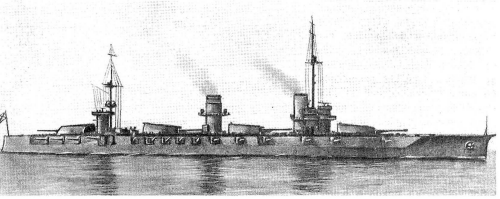
NAVYPEDIA
 Support the project with paypal
Support the project with paypal
Photo

Imperatritsa Yekaterina Velikaya
Ships
| Name | No | Yard No | Builder | Laid down | Launched | Comp | Fate |
|---|---|---|---|---|---|---|---|
| Императрица Мария [Imperatritsa Mariya] | Russud, Nikolayev | 30.10.1911 | 1.11.1913 | 6.7.1915 | explosion 20.10.1916 | ||
| Императрица Екатерина Великая [Imperatritsa Yekaterina Velikaya] (ex-Екатерина II [Yekaterina II]), 4.1917- Свободная Россия [Svobodnaya Rossiya] | Naval, Nikolayev | 30.10.1911 | 6.6.1914 | 18.10.1915 | scuttled 18.6.1918 | ||
| Воля [Volia] (ex-Император Александр III [Imperator Alexandr III]), 10.1920- Генерал Алексеев [General Alekseyev] | Russud, Nikolayev | 30.10.1911 | 15.4.1914 | 28.6.1917 | captured by Germany 1.10.1918 (Volya), to Whites 10.1920, interned by France 29.12.1920, BU |
Technical data
| Displacement normal, t | Imperatritsa Mariya, Voia: 22600 Imperatritsa Yekaterina Velikaya: 23783 |
|---|---|
| Displacement full, t | Imperatritsa Mariya, Volia: 24000 Imperatritsa Yekaterina Velikaya: 24960 |
| Length, m | Imperatritsa Mariya, Volia: 167.8 Imperatritsa Yekaterina Velikaya: 169.8 |
| Breadth, m | Imperatritsa Mariya, Volia: 27.3 Imperatritsa Yekaterina Velikaya: 27.9 |
| Draught, m | 8.40 |
| No of shafts | 4 |
| Machinery | Imperatritsa Mariya, Imperatritsa Yekaterina Velikaya: 4 Parsons steam turbines, 20 Yarrow boilers Volia: 4 Brown-Curtis steam turbines, 20 Yarrow boilers |
| Power, h. p. | Imperatritsa Mariya, Volia: 26500 Imperatritsa Yekaterina Velikaya: 27000 |
| Max speed, kts | 21 |
| Fuel, t | coal 3000 + oil 720 |
| Endurance, nm(kts) | 1400(12) |
| Armour, mm | belt: 267 - 100, turrets: 250, barbettes: 250 - 125, funnel uptakes: 75, decks: 75 - 37, CT: 300 |
| Armament | Imperatritsa Mariya: 4 x 3 - 305/50, 20 x 1 - 130/53, 4 x 1 - 75/48 Canet, 4 x 1 - 47/40 Hotchkiss, 4 x 1 - 7.6/94, 4 - 450 TT (sub, beam) Imperatritsa Yekaterina Velikaya: 4 x 3 - 305/50, 20 x 1 - 130/53, 3 x 1 - 75/48 Canet, 4 x 1 - 47/40 Hotchkiss, 4 x 1 - 7.6/94, 4 - 450 TT (sub, beam) Volia: 4 x 3 - 305/50, 18 x 1 - 130/53, 8 x 1 - 75/48 Canet, 4 x 1 - 47/40 Hotchkiss, 4 x 1 - 7.6/94, 4 - 450 TT (sub, beam) |
| Complement | 1220 |
Standard scale images

Volya 1917
Graphics
Project history
Authorised under the 1911 Programme. The preliminary characteristics issued by the Technical Committee provided for 20000t, 20.5kts battleships armed with 305mm guns. The Naval Staff rejected this idea and demanded 356mm, 22kt ships to follow development trends of the day and to counter the Resadiye class battleships ordered by Turkey. Unfortunately for the Russians the 356mm guns were then only in the earliest stage of development in the Obukhov Works at that time and it was therefore decided to mount 305mm to avoid delays. The general layout was modelled on the Gangut class but the new capital ships were to be pure battleships unlike the previous class and with protection substantially improved. Disposition of casemates showed signs of improvement as compared with the Gangut class but interference with the main calibre guns was not avoided in all cases.
Financial problems hampered Naval Staff requirements and the speed was reduced to 21kts and the displacement limited to 21500t normal. The same reason caused abandonment of the 1911 proposals for 24kts and increased protection. The authorised displacement was increased by 1100t to fulfil requirements already settled on, while Imperatritsa Yekaterina Velikaya exceeded twice this figure. Such a divergence between her and the remaining pair was due to the various supervisory firms of the Russud Yd and Naval Yd, backed by John Brown Yd and Vickers Yd respectively. Initially cage masts were planned but pole ones were fitted instead.
The first pair was completed in 1915 (Yekaterina II was renamed on 27 June 1915) with their light guns outfit varying from the designed one in the light of war experience. Commissioning of 2 dreadnoughts shifted the balance of power in the Black Sea to the Russian side and enabled the Black Sea Fleet to bombard the Turkish and Bulgarian shore installations.
Despite being given top priority in July 1915 Imperator Alexandr III entered service only after the February Revolution being renamed Volya on 29 April 1917 while Imperatritsa Yekaterina Velikaya became Svobodnaya Rossiya on the same day. Volia varied from the prototype in details, having an AA armament consisting of 4-75mm placed one by one atop the foremost turrets on the centreline, while the forward casemate hole on either side was plated out. This was introduced when it became evident that Imperatritsa Mariya had a tendency when in a seaway to ship a large amount of water through her forward casemates. The hull of Svobodnaya Rossiya being 2m longer presented no such problems so the forward 130mm guns were retained.
Ship protection
The 262mm belt (112m long) extended to 1.75m under lwl tapering to 125mm at lower edge and was backed by a 50mm (25mm near ship ends) longitudinal bulkhead extended down to form the armoured torpedo bulkhead. Small 24m long part between main belt and the stem was 125mm (tapering to 75mm at lower edge). Aft part of the belt consisted of two strakes: 125mm lower from the lower edge to 1m above the lwl and 100mm upper strake. Upper belt (130mm casemate) had 100mm thickness at 121m length and 75mm at 24m part from the stem, in 23m from the stern it was closed by 100mm bulkhead. Upper deck over the battery on 121m length had 38mm thickness, its 24m fore part was 25mm. Medium deck was 38mm near the sides and 25mm near the centreline. Lower deck on the aft part of hull had 25mm thickness. Barbettes had 250mm protection over the upper deck and 150(for end turrets) - 125mm (for medium turrets and inner parts of end barbettes) under the upper deck. Turrets had 250mm faces, sides and rears and 100mm roofs. Main CT had 300mm sides and 200mm roof, aft CT had 300mm sides and 120mm roof.
Modernizations
None.
Naval service
Imperatritsa Mariya capsized 20.10.1916 at Sevastopol as a result of internal explosion caused by unstable propellant. The wreck was raised in 1918 and broken up in 1922.
After the October Revolution Svobodnaya Rossiya went over to the Bolshevik side and she followed the order to leave Sevastopol for Novorossiysk in April 1918 to escape the advancing Germans. When Novorossiysk fell the destroyer Kerch sank her with torpedoes. Volia was forced by the Bolshevik ships to leave Sevastopol she returned there two weeks later being seized by the Germans (19.6.1918) who commissioned her 1.10.1918 as Volya. She was able to perform only one trial cruise off the Bosphorus and in 24.11.1918 she passed under British control. In April 1919 she was sent to Izmid in Turkey to prevent capture by the Reds. She was transferred to Wrangel's fleet on 17 October and commissioned as General Alekseyev performing well until the capitulation of the Crimea. She escaped to Bizerte 14.11.1920 and interned at Bizerte by French 29.12.1920. 29.10.1924 she was admitted by French Government as Soviet property but sold for BU in late 1920s and scrapped in 1936 in France.
 HOME
HOME FIGHTING SHIPS OF THE WORLD
FIGHTING SHIPS OF THE WORLD RUSSIA / USSR
RUSSIA / USSR CAPITAL SHIPS AND MONITORS
CAPITAL SHIPS AND MONITORS IMPERATRITSA MARIYA battleships (1915 - 1917)
IMPERATRITSA MARIYA battleships (1915 - 1917)
